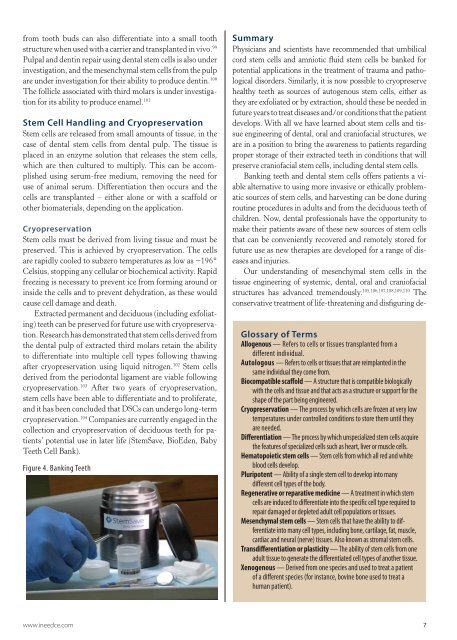Stem Cells: Sources, Therapies and the Dental ... - IneedCE.com
Stem Cells: Sources, Therapies and the Dental ... - IneedCE.com
Stem Cells: Sources, Therapies and the Dental ... - IneedCE.com
You also want an ePaper? Increase the reach of your titles
YUMPU automatically turns print PDFs into web optimized ePapers that Google loves.
from tooth buds can also differentiate into a small tooth<br />
structure when used with a carrier <strong>and</strong> transplanted in vivo. 99<br />
Pulpal <strong>and</strong> dentin repair using dental stem cells is also under<br />
investigation, <strong>and</strong> <strong>the</strong> mesenchymal stem cells from <strong>the</strong> pulp<br />
are under investigation for <strong>the</strong>ir ability to produce dentin. 100<br />
The follicle associated with third molars is under investigation<br />
for its ability to produce enamel. 101<br />
<strong>Stem</strong> Cell H<strong>and</strong>ling <strong>and</strong> Cryopreservation<br />
<strong>Stem</strong> cells are released from small amounts of tissue, in <strong>the</strong><br />
case of dental stem cells from dental pulp. The tissue is<br />
placed in an enzyme solution that releases <strong>the</strong> stem cells,<br />
which are <strong>the</strong>n cultured to multiply. This can be ac<strong>com</strong>plished<br />
using serum-free medium, removing <strong>the</strong> need for<br />
use of animal serum. Differentiation <strong>the</strong>n occurs <strong>and</strong> <strong>the</strong><br />
cells are transplanted – ei<strong>the</strong>r alone or with a scaffold or<br />
o<strong>the</strong>r biomaterials, depending on <strong>the</strong> application.<br />
Cryopreservation<br />
<strong>Stem</strong> cells must be derived from living tissue <strong>and</strong> must be<br />
preserved. This is achieved by cryopreservation. The cells<br />
are rapidly cooled to subzero temperatures as low as −196°<br />
Celsius, stopping any cellular or biochemical activity. Rapid<br />
freezing is necessary to prevent ice from forming around or<br />
inside <strong>the</strong> cells <strong>and</strong> to prevent dehydration, as <strong>the</strong>se would<br />
cause cell damage <strong>and</strong> death.<br />
Extracted permanent <strong>and</strong> deciduous (including exfoliating)<br />
teeth can be preserved for future use with cryopreservation.<br />
Research has demonstrated that stem cells derived from<br />
<strong>the</strong> dental pulp of extracted third molars retain <strong>the</strong> ability<br />
to differentiate into multiple cell types following thawing<br />
after cryopreservation using liquid nitrogen. 102 <strong>Stem</strong> cells<br />
derived from <strong>the</strong> periodontal ligament are viable following<br />
cryopreservation. 103 After two years of cryopreservation,<br />
stem cells have been able to differentiate <strong>and</strong> to proliferate,<br />
<strong>and</strong> it has been concluded that DSCs can undergo long-term<br />
cryopreservation. 104 Companies are currently engaged in <strong>the</strong><br />
collection <strong>and</strong> cryopreservation of deciduous teeth for patients’<br />
potential use in later life (<strong>Stem</strong>Save, BioEden, Baby<br />
Teeth Cell Bank).<br />
Figure 4. Banking Teeth<br />
Summary<br />
Physicians <strong>and</strong> scientists have re<strong>com</strong>mended that umbilical<br />
cord stem cells <strong>and</strong> amniotic fluid stem cells be banked for<br />
potential applications in <strong>the</strong> treatment of trauma <strong>and</strong> pathological<br />
disorders. Similarly, it is now possible to cryopreserve<br />
healthy teeth as sources of autogenous stem cells, ei<strong>the</strong>r as<br />
<strong>the</strong>y are exfoliated or by extraction, should <strong>the</strong>se be needed in<br />
future years to treat diseases <strong>and</strong>/or conditions that <strong>the</strong> patient<br />
develops. With all we have learned about stem cells <strong>and</strong> tissue<br />
engineering of dental, oral <strong>and</strong> craniofacial structures, we<br />
are in a position to bring <strong>the</strong> awareness to patients regarding<br />
proper storage of <strong>the</strong>ir extracted teeth in conditions that will<br />
preserve craniofacial stem cells, including dental stem cells.<br />
Banking teeth <strong>and</strong> dental stem cells offers patients a viable<br />
alternative to using more invasive or ethically problematic<br />
sources of stem cells, <strong>and</strong> harvesting can be done during<br />
routine procedures in adults <strong>and</strong> from <strong>the</strong> deciduous teeth of<br />
children. Now, dental professionals have <strong>the</strong> opportunity to<br />
make <strong>the</strong>ir patients aware of <strong>the</strong>se new sources of stem cells<br />
that can be conveniently recovered <strong>and</strong> remotely stored for<br />
future use as new <strong>the</strong>rapies are developed for a range of diseases<br />
<strong>and</strong> injuries.<br />
Our underst<strong>and</strong>ing of mesenchymal stem cells in <strong>the</strong><br />
tissue engineering of systemic, dental, oral <strong>and</strong> craniofacial<br />
structures has advanced tremendously. 105,106,107,108,109,110 The<br />
conservative treatment of life-threatening <strong>and</strong> disfiguring de-<br />
Glossary of Terms<br />
Allogenous — Refers to cells or tissues transplanted from a<br />
different individual.<br />
Autologous — Refers to cells or tissues that are reimplanted in <strong>the</strong><br />
same individual <strong>the</strong>y <strong>com</strong>e from.<br />
Bio<strong>com</strong>patible scaffold — A structure that is <strong>com</strong>patible biologically<br />
with <strong>the</strong> cells <strong>and</strong> tissue <strong>and</strong> that acts as a structure or support for <strong>the</strong><br />
shape of <strong>the</strong> part being engineered.<br />
Cryopreservation — The process by which cells are frozen at very low<br />
temperatures under controlled conditions to store <strong>the</strong>m until <strong>the</strong>y<br />
are needed.<br />
Differentiation — The process by which unspecialized stem cells acquire<br />
<strong>the</strong> features of specialized cells such as heart, liver or muscle cells.<br />
Hematopoietic stem cells — <strong>Stem</strong> cells from which all red <strong>and</strong> white<br />
blood cells develop.<br />
Pluripotent — Ability of a single stem cell to develop into many<br />
different cell types of <strong>the</strong> body.<br />
Regenerative or reparative medicine — A treatment in which stem<br />
cells are induced to differentiate into <strong>the</strong> specific cell type required to<br />
repair damaged or depleted adult cell populations or tissues.<br />
Mesenchymal stem cells — <strong>Stem</strong> cells that have <strong>the</strong> ability to differentiate<br />
into many cell types, including bone, cartilage, fat, muscle,<br />
cardiac <strong>and</strong> neural (nerve) tissues. Also known as stromal stem cells.<br />
Transdifferentiation or plasticity — The ability of stem cells from one<br />
adult tissue to generate <strong>the</strong> differentiated cell types of ano<strong>the</strong>r tissue.<br />
Xenogenous — Derived from one species <strong>and</strong> used to treat a patient<br />
of a different species (for instance, bovine bone used to treat a<br />
human patient).<br />
www.ineedce.<strong>com</strong> 7

















